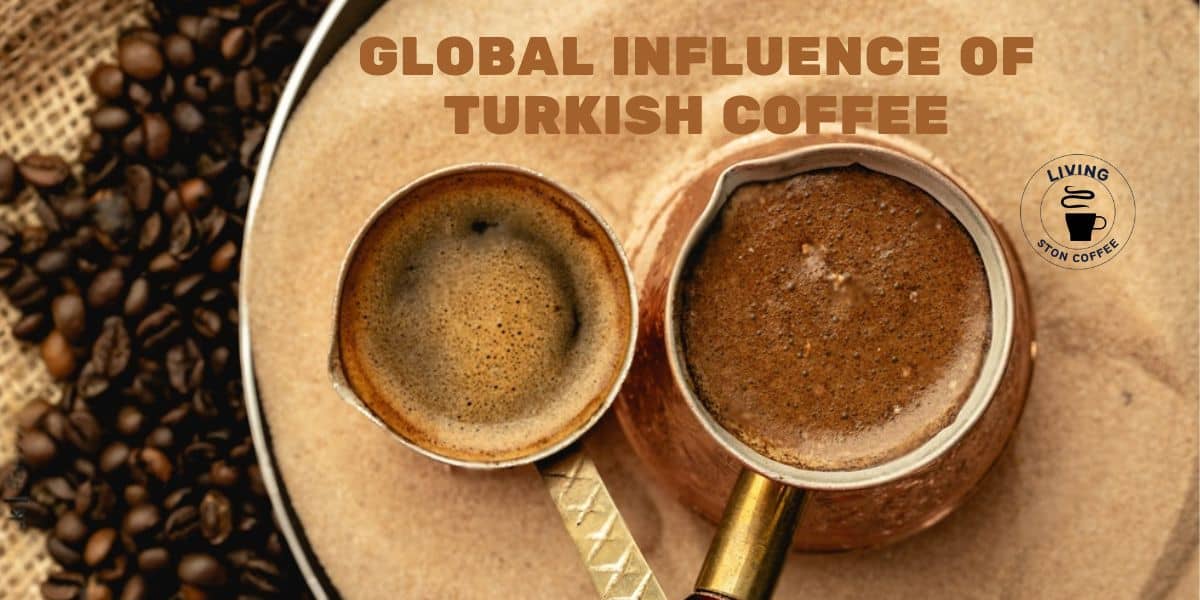Turkish coffee is typically stronger than espresso due to its brewing method and higher caffeine content per volume. Espresso, while concentrated, has a different preparation and serving size that affects its strength.
Exploring the vibrant world of coffee, aficionados often compare Turkish coffee to espresso, considering both are praised for their robust flavors and energizing effects. Known for its unique preparation involving finely ground coffee beans unfiltered and boiled with water and sugar, Turkish coffee offers a potent brew with a strength surpassing the well-known espresso.
On the other hand, espresso, originating from Italy, is made by forcing hot water through tightly-packed, finely-ground coffee, resulting in a smaller, but highly concentrated shot. The comparison between the two is quite popular among coffee enthusiasts, each beverage boasting a loyal following for its distinct taste and cultural significance. These rich traditions and flavors reflect the diversity within the world of coffee, catering to various preferences and palates.
The Roots Of Richness
Coffee enthusiasts often ponder over the strength of their brews. Turkish coffee and espresso, each with its own heritage, offer unique experiences of rich flavors and intense caffeine kicks. Let’s explore their origins to understand their powerful allure.
Turkish Coffee Tradition
Turkish coffee is a celebrated ritual, steeped in history and social culture. The preparation begins with fine coffee grounds, often with added cardamom, simmered but never boiled. Its preparation in a cezve, a special pot, ensures a strong, unfiltered coffee that settles at the bottom.
- Grounds are measured with care for consistent strength.
- The heat is meticulously controlled to create a rich foam.
- Each cup is a work of patience and technique, ensuring high caffeine levels.
Espresso’s Italian Heritage
Espresso hails from Italy, a land passionate about its coffee. Invented in the early 20th century, espresso is famously concentrated. It’s made with a fine grind, similar to Turkish coffee, but brewed under high pressure. This process extracts the heart of the bean for a small, potent shot.
| Characteristic | Espresso | Turkish Coffee |
|---|---|---|
| Grind Type | Fine | Extra Fine |
| Brewing Method | Pressure Extraction | Simmering |
| Serving Size | Small Shot | Small Cup |
| Caffeine Content | High | Higher due to grounds |
Both brewing methods highlight distinctive strength and richness. The caffeine content in Turkish coffee often surpasses espresso because of the grinds left in the cup. Yet, espresso delivers its own robust kick in a small but mighty package.
Unpacking The Beans
Are you curious about the power punch Turkish coffee and espresso deliver? It lies within their beans. Different beans lead to unique strengths and flavors. Let’s dive into the world of beans and explore how they shape our beloved Turkish coffee and espresso.
Arabica Vs. Robusta
Turkish coffee and espresso often differ in their bean choices. Espresso usually favors Arabica beans, known for their smooth, delicate flavor. On the other hand, traditional Turkish coffee might include Robusta beans, synonymous with a stronger, more bitter taste.
Key differences:
- Arabica: Sweeter, complex flavors, and less caffeine.
- Robusta: Stronger, earthier taste, and more caffeine.
Bean Origin And Flavor Profile
Bean origin plays a crucial role in taste. Espresso’s Arabica beans often hail from Latin America, Africa, or Asia. Each region imparts distinctive notes and nuances.
| Region | Flavor Notes |
|---|---|
| Latin America | Nutty, cocoa, mild fruity hints |
| Africa | Floral, berry-like, citrus undertones |
| Asia | Earthy, bold, dark flavors |
Turkish coffee beans may come from the same regions but are often more finely ground. The fine grounds and unique brewing technique contribute to Turkish coffee’s intense taste and higher caffeine content in a small cup.
Behind The Brew
Welcome to the Behind the Brew section of our coffee exploration where we dive into the classic showdown between two beloved, yet different, coffee powerhouses: Turkish coffee and espresso. These delectable brews each boast their own unique traditions, flavors, and yes, caffeine levels. Let’s pull back the curtain on how these potent potions come to life and see which might be the stronger contender.
Turkish Coffee Preparation
Turkish coffee’s strength doesn’t just come from its caffeine content, it’s also about its preparation method. Here’s what sets it apart:
- Finely ground coffee beans: The coffee is ground to a fine powder, finer than what’s used for espresso.
- No filter used: The ground coffee is not filtered out, resulting in a stronger and thicker concoction.
- Specialized pot: Cooked in a cezve, a traditional coffee pot, the coffee is combined with water and often sugar, then heated until frothy.
- Slow heating process: Turkish coffee simmers slowly, enhancing the full flavor and allowing for a robust buildup of caffeine.
The result? A full-bodied brew known for its rich texture and bold taste.
Espresso Extraction Techniques
Espresso, iconic in its own right, follows a distinct process:
- Fine but not powdered: Espresso uses a fine grind, but not as powdery as Turkish coffee.
- High pressure: Water is forced through the coffee grounds using high pressure, extracting rich flavors and oils.
- Short brewing time: Espresso is made quickly, usually within 20-30 seconds, to produce a concentrated shot.
- Measured servings: Often served in small, 1-ounce shots, espresso delivers a potent dose of caffeine in a tiny package.
Espresso’s trademark is the crema—a creamy foam on top, signaling a perfect extraction.
Both Turkish coffee and espresso pack a punch when it comes to flavor and caffeine concentration. The choice between a cup of velvety Turkish brew or a sharp, rich shot of espresso depends on personal preference. Discover which resonates with your taste buds and caffeine needs!
Caffeine Content Clash
Welcome to the Caffeine Content Clash, a duel between two titans of the coffee world: Turkish coffee and espresso. Like David and Goliath, these beverages pack a punch in small packages, but which one truly reigns supreme in sheer strength? Let’s dive into an astonishing comparison of caffeine levels and see who comes out on top.
Comparing Milligrams Per Ounce
It’s a showdown of caffeine concentration where every milligram counts. Here’s what the numbers tell us:
| Coffee Type | Caffeine per Ounce (mg) |
|---|---|
| Turkish Coffee | Approx. 50mg |
| Espresso | Approx. 63mg |
Espresso might look like the clear winner, but there’s more to this story than meets the eye.
The Role Of Serving Size
When talking caffeine content, size does matter. Let’s look at standard servings:
- A single shot of espresso typically holds 1 ounce.
- A cup of Turkish coffee is about 2 ounces.
This means a full serving of Turkish coffee comes in strong with about 100mg of caffeine.
In contrast, a shot of espresso serves up about 63mg.
To truly gauge the champion, consider total caffeine consumed per serving. That puts Turkish coffee ahead, not just sip for sip, but in the full coffee experience.
Sensory Experience
Turkish coffee and espresso offer unique coffee experiences. Both drinks boast bold flavors that captivate the senses. As we dive into the sensory experience, let’s explore how Turkish coffee and espresso differentiate themselves.
Aroma And Acidity
The moment Turkish coffee begins to brew, a rich, spicy aroma fills the air. Its robust scent is often heightened by cardamom. The roasting process of Turkish coffee beans creates a distinctive smell that is more intense compared to that of espresso.
In contrast, espresso greets the nose with a more fruity and floral bouquet, influenced by the bean’s origin and roast. When it comes to acidity, espresso typically has a higher level, which translates to a sharper, tangy taste – a lively kick to your testbeds.
Bitterness And Body
Bitterness in coffee is a tell-tale sign of caffeine presence, alongside other compounds. Between our two contenders, Turkish coffee takes the lead in this category. The fine grind and long contact with water extract more of these bitter elements, resulting in a more potent flavor.
The body of Turkish coffee is notably thicker and velvety, almost syrup-like. Espresso, while still rich, offers a lighter creamy texture. Its signature crema adds a smooth layer that softens the drink’s overall profile.
Without a doubt, both Turkish coffee and espresso provide dynamic and bold sensory experiences. They invite coffee lovers to savor differing levels of aroma, acidity, bitterness, and body, each magnificent in its own right.
Cultural Sipping Habits
Imagine two worlds of coffee traditions. One from the vibrant streets of Istanbul, the other from Italy’s bustling cafes. Both countries take pride in their famous brews. Turkish coffee and espresso are legends on their own. Yet each holds a different place in their culture’s heart. Let’s explore these unique sipping habits through the lens of local rituals.
The Turkish Savor
In every sip of Turkish coffee, there is history and patience. Unlike the espresso shot, this drink is slowly savored. Often, it’s enjoyed alongside water and sweets like Turkish delight. Here’s how to appreciate it:
- Sip slowly to taste the rich flavor.
- Use water to cleanse the palate.
- Repeat and relax.
Turkish coffee sessions are not just about drinking. They’re about conversation and connection. They can last for hours. Each cup is a mini-ceremony.
The Italian Quick Shot
In contrast, Italians prefer a quick, intense espresso experience. Like the roar of a Vespa zipping by, espresso is downed in seconds. A espresso bar is where this happens. With speed and efficiency, you:
- Order your shot.
- Drink it standing at the bar.
- Continue your day with a caffeinated kick!
This method reflects the Italian pace of life. Fast, expressive, and always on the move. It’s not just coffee; it’s a daily ritual.
Imperial Impacts
Imperial Impacts: Have you ever wondered how global empires have influenced your morning brew? The histories of both Turkish coffee and espresso weave tales of power and sociocultural transformation. Each has left a profound mark on the world’s coffee culture.
Global Influence Of Turkish Coffee
The story of Turkish coffee stretches back to the Ottoman Empire. Its tradition began in the 15th century. Ottoman palaces treasured this unique method of preparation. Turkish coffee’s influence expanded as the empire grew.
- Celebrations often featured this black, potent drink.
- Its preparation and enjoyment became a social ritual.
- It even inspired the world-famous Turkish hospitality.
Today, its global spread continues. Turkish coffee impacts cultures far beyond its origins. This delicate craft has earned a UNESCO Intangible Cultural Heritage designation.
Espresso’s Worldwide Revolution
Espresso emerged from Italy in the early 20th century. It represents Europe’s industrial progress and café culture. Espresso quickly became a symbol for speed and efficiency. In fact, the word “espresso” means “expressed” or “forced out”.
| Country | Influence of Espresso |
|---|---|
| Italy | The heart of espresso, it fueled the busy lives of Italians. |
| France | Café culture adopted espresso, blending it with Parisian flair. |
| United States | Starbucks popularized the espresso, transforming local coffee scenes. |
Espresso machines revolutionized coffee consumption worldwide. Baristas now craft countless drinks using its concentrated base. From lattes to cappuccinos, espresso is at the heart of today’s coffee revolution.
Finding Your Strength
Welcome to the world of robust coffee experiences, where finding the perfect strength to kick-start your day or to savor a leisurely afternoon is a personal quest. In the realm of intense flavors, two strong contenders stand out: Turkish coffee and espresso. Now let’s dive into what makes each unique, and how you might land on your favorite.
Personal Preferences
Your journey to the ideal coffee strength is much like finding the perfect pair of shoes—it’s different for everyone! Turkish coffee and espresso both pack a punch, but in distinct ways.
- Turkish coffee is steeped in tradition, offering a thick, syrupy texture and potent taste. Its unfiltered nature leaves a notable sediment that’s not for everyone.
- Espresso delivers a concentrated shot with a creamy crema. Its smooth yet potent flavor profile can be intense, but often without the sediment found in Turkish brews.
Choosing the right one relies on your flavor and texture preferences. Do you enjoy a full-bodied brew or a velvety shot of caffeine? This choice shapes your strength preference.
Guidance For Coffee Lovers
To navigate the choice between Turkish coffee and espresso, consider the following tips:
| Coffee Type | Caffeine Content | Taste Profile | Recommended For |
|---|---|---|---|
| Turkish Coffee | High (Varies) | Cardamom, Bittersweet, Bold | Adventurous palates, lovers of rich texture |
| Espresso | High (Concentrated) | Sharp, Creamy, Intense | Those seeking a quick, strong hit of coffee |
Analyze your caffeine tolerance and what flavor notes excite your palate. Turkish coffee, with its spice-infused aroma, may intrigue some. Others might prefer the straight-up jolt of pure coffee from an espresso shot.
Experiment with both styles in different settings. A quiet evening may pair well with a comforting cup of Turkish coffee. A busy morning might call for the swift boost of an espresso. Finding your strength is a sensory exploration that’s personal and pleasurable.
Frequently Asked Questions On Is Turkish Coffee Stronger Than Espresso?
Is Turkish Coffee The Strongest Coffee?
Turkish coffee is renowned for its strong flavor, but it’s not the highest in caffeine content. Other brewing methods, like espresso, can produce stronger coffee in terms of caffeine concentration.
How Does Turkish Coffee Compare To Espresso?
Turkish coffee is brewed with finely ground beans without filtering, resulting in a strong, thick beverage. Espresso uses finely ground beans and pressure, creating a concentrated shot with crema on top. Both are bold but differ in preparation and texture.
Does Turkish Coffee Have More Caffeine?
Turkish coffee does not necessarily contain more caffeine than other brewing methods; the caffeine content varies based on the coffee bean type and serving size.
Is Turkish Coffee Stronger Than Instant Coffee?
Yes, Turkish coffee is generally stronger than instant coffee due to its fine grind and brewing method which preserves more caffeine.
Conclusion
Unveiling the depths of coffee culture, we’ve stirred through facts. Turkish coffee boasts a bold character. Yet, espresso’s concentration challenges its potency. Personal taste tips the scale. Embrace your preference and let it guide your coffee journey. Remember, strength lies not just in beans, but in the brewing.





